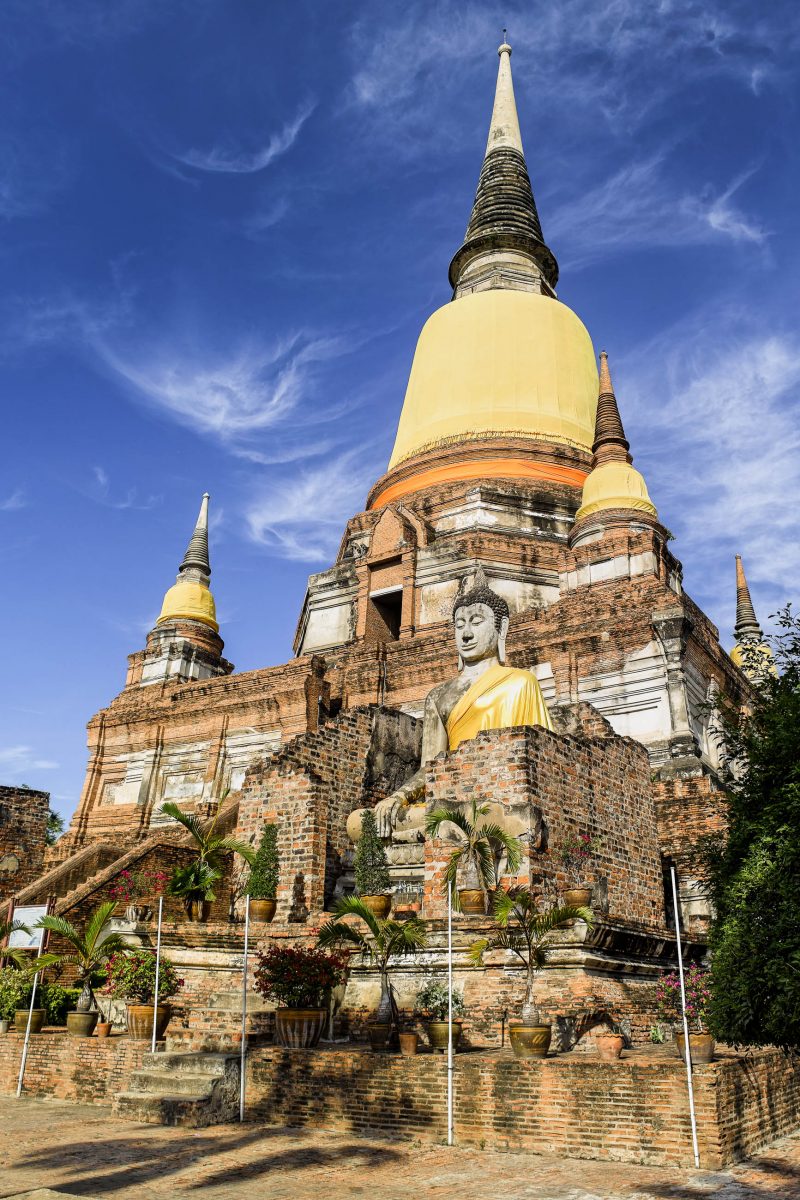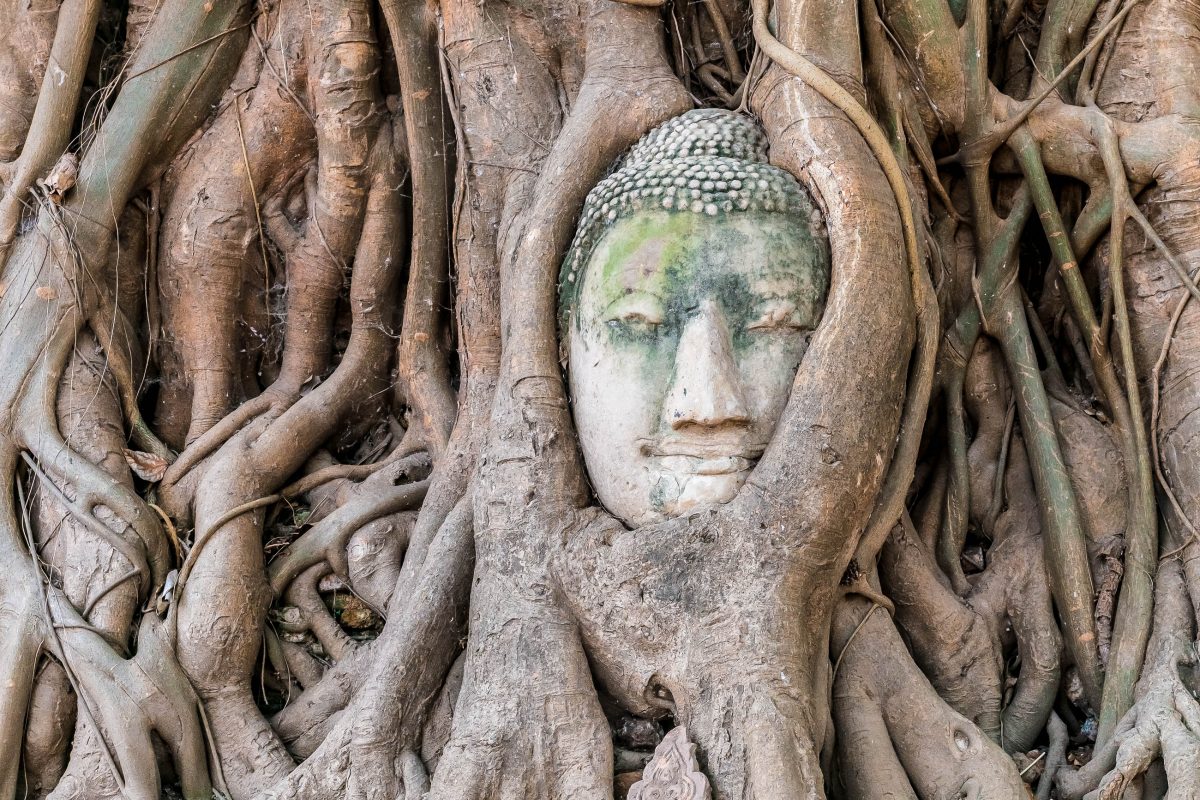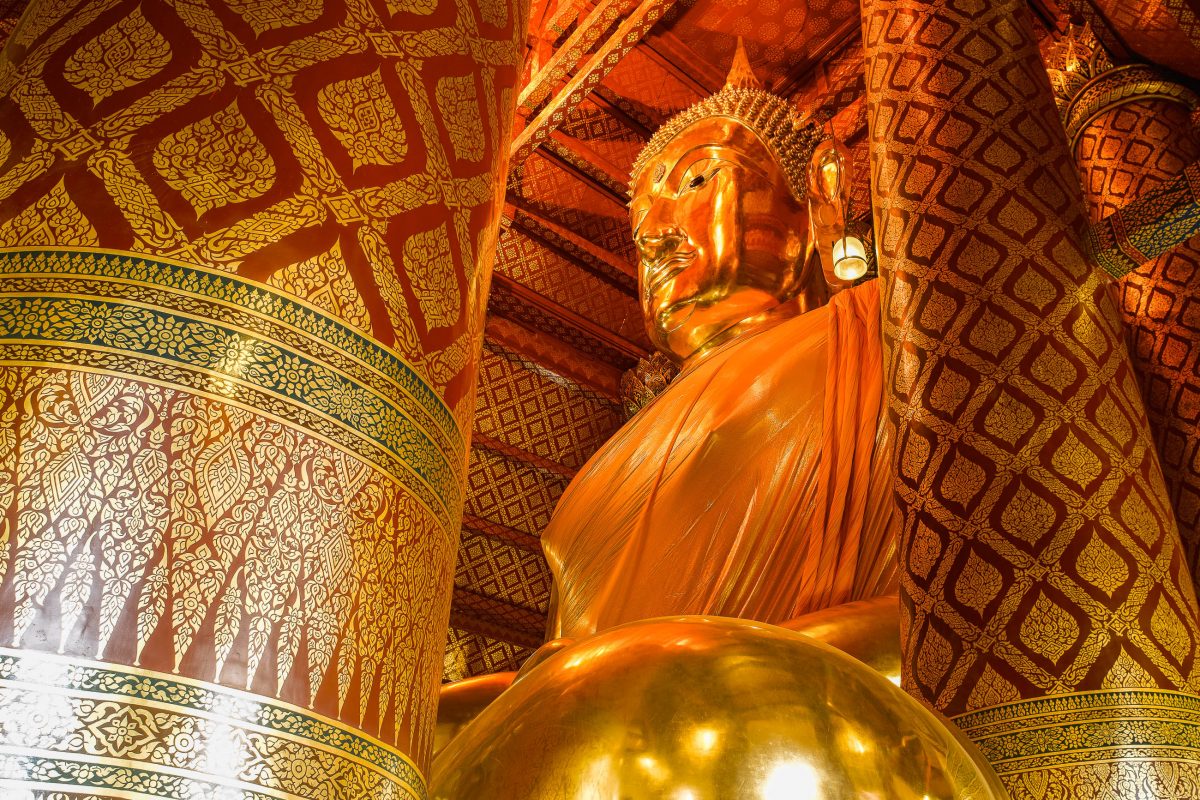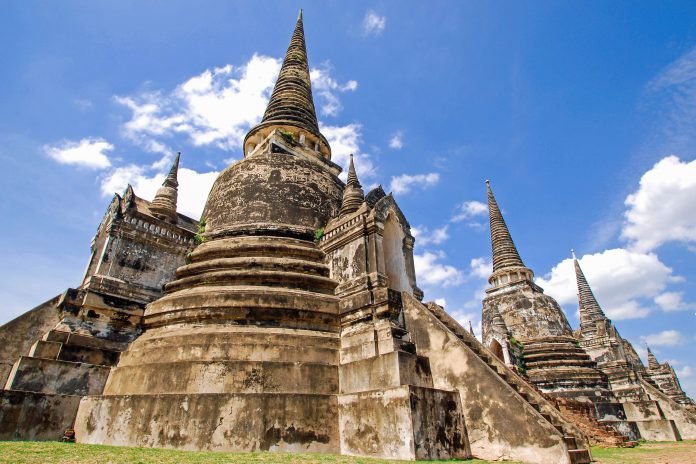Die Ruinenstadt Ayutthaya liegt gut 70km von der thailändischen Hauptstadt entfernt. Die Metropole des einstigen siamesischen Königreiches wurde im 18. Jahrhundert zerstört und liegt zum Großteil immer noch im Trümmern. Einige der grandiosen Tempelanlagen wurden restauriert und können auch von innen besichtigt werden.
Die historische Stadt Ayutthaya im Zentrum von Thailand wurde am 4. März 1351 (das genaue Datum ist in den penibel dokumentierten „Königlichen Chroniken von Ayutthaya“ verzeichnet) vom thailändischen König U Thong gegründet als Hauptstadt des Königreichs Siam gegründet. Heute sind die Überreste von der einst stattlichen Hauptstadt in einem Geschichtspark zu besichtigen, der seit 1981 zum Weltkulturerbe der UNESCO zählt.
Inhaltsverzeichnis
Ayutthaya als siamesische Metropole
Die Hauptstadt Siams war einst eine der prächtigsten und wohlhabendsten Städte Asiens mit etwa einer Million Einwohner. Über 30.000 Priester wachten über die 1.700 Tempel und deren unermessliche Goldschätze, darunter ganze Buddhastatuen aus massivem Gold. Doch ihr Ruhm währte nur bis zum Jahr 1767, als Ayutthaya von birmanischen Truppen vollkommen zerstört und restlos geplündert wurde.
Knapp 200 Jahre später wurde durch die thailändische Kunstakademie mit dem Wiederaufbau begonnen. 1976 wurde Ayutthaya zu einem Geschichtspark ernannt und die Restaurierungsarbeiten weiter vorangetrieben.
Besuch in der Ruinenstatt Ayutthaya

Ayutthaya liegt etwa 70km von der thailändischen Hauptstadt Bangkok entfernt und ist per Bus und Bahn gut zu erreichen. Im Prinzip kann die altehrwürdige Anlage heute mit einem riesigen historischen Trümmerhaufen verglichen werden. Was die Burmesen stehen ließen, wurde später von Bauherren, die Steine für ihre Häuser brauchten (unter anderem für den neuen Königspalast in Bangkok), und Wind und Wetter arg in Mitleidenschaft gezogen.
Zwischen den restaurierten Gebäuden liegen immer noch Unmengen von uralten Steinen herum. Das Paradies für Hobby-Archäologen und Kulturinteressierte, ein Abenteuer-Spielplatz für Kinder. Für die Besichtigung mancher Tempel wird Eintritt verlangt, der Geschichtspark selbst kann kostenlos erkundet werden.
Trotz seines wüsten Erscheinungsbildes ist der Geschichtspark eine fantastische Entdeckungsreise durch exotische Paläste, Unmengen von Buddhastatuen und Figuren, die zwischen mächtigen Baumwurzeln hervor blinzeln, alles umgeben vom mystischen Hauch der Vergangenheit. Die tropische Atmosphäre und die uralten Tempel schaffen eine ganz eigene Stimmung, die noch durch den Umstand verstärkt wird, dass zum Beispiel auch im Garten des Spitals von Ayutthaya ein 500 Jahre alter „Chedi“, einer der berühmten steinernen Spitztürme, aufragt.
Mitten durch Ayutthaya ziehen sich mehrere Flussläufe, die im Zentrum eine 3 mal 1,5km große Insel bilden. Auf dieser befindet sich die so genannte „alte Stadt“ mit den meisten bedeutenden Sehenswürdigkeiten. Um einen Überblick über die Tempelanlage zu erhalten, empfiehlt sich eine etwa 2stündige Umrundung mit dem Boot, von der aus sich schon perfekte Fotomotive bieten.
Verhaltenskodex: Ayutthaya ist trotz seiner Zerstörung nach wie vor eine religiöse Anlage. Lautes Rufen oder Herumlaufen sollte unterlassen werden, ebenso, auf Statuen und Türme zu klettern, oder sie auch nur mit den Füßen zu berühren. Vor dem Betreten von Tempeln müssen die Schuhe abgelegt werden. Zerstörte Statuen zu fotografieren, gilt als respektlos.
Die Tempel von Ayutthaya
Der gigantische Wat Phra Sri Sanphet südlich des Palastgeländes ist schon von weitem sichtbar. Mit seinen drei imposanten „Chedis“ (von Chetiya, wörtlich etwa: „aufhäufen“), spitz zulaufenden Turmbauten, gilt er als Wahrzeichen von Ayutthaya und ist wohl das bekannteste und meist fotografierte Gebäude. Es zeigt am besten den ehemaligen Glanz von Ayutthaya, auch das Ausmaß der Zerstörung durch die Burmesen kann anhand der abgeschlagenen Buddhaköpfe und Risse in den Mauern nachvollzogen werden.
Der Tempel Wat Phra Ram wurde von König Ramesuan in Auftrag gegeben. Die Tempelanlage des Wat Ratchaburana wurde vom siamesischen Köing Chao Sam Phraya erbauen lassen. In der begehbaren Krypta wurden fantastische Goldschätze gefunden, darunter ein kniender Elefant.
Die wertvollen Funde sind im Chao Sam Phraya Nationalmuseum ausgestellt, welches sich ebenfalls in der „Alten Stadt“ befindet und einen Eindruck vom früheren Wohlstand von Ayutthaya vermittelt. Neben den beiden klimatisierten Schatzkammern wird auch ein wunderschönes thailändisches Haus der gehobenen Klasse gezeigt, welches ein Gefühl für das Leben in Thailand vor 200 Jahren vermittelt.

Der Tempel Wat Mahathat aus dem Jahr 1374 fungierte als rituelles Zentrum von Ayutthaya. Gleich rechts lugt zwischen Baumwurzeln der Kopf einer von den Burmesen geköpften Buddhastatue hervor.
Der Wat Suwan Dararam stammt aus einer späten Bauperiode Ayutthayas. Im Wat Lokaya Sutharam ist ein 42m langer liegender Buddha aus Stein zu bestaunen, der alle drei Monate zeremoniell in ein neues „Gewand“ aus meterlangen Stoffbahnen gekleidet wird.
Der Wang Luang, oder „Alte Palast“ im Norden der Insel wurde von den meisten Königen von Siam als Residenz auserkoren. Nicht so zum Beispiel König Naresuan, der Große. Er verbrachte seine Regierungszeit im 16. Jahrhundert im Chandra-Kasem-Palast. Eine Reiterstatue des Königs befindet sich vor dem Wat Phu Khao Thong.
Der Wat Phu Khao Thong befindet sich im Norden der Insel. Er wurde nicht mehr von den Siamesen, sondern bereits vom birmanischen König nach der ersten Eroberung Ayutthayas im Jahr 1569 in Auftrag gegeben. Der 80m hohe schneeweiße Chedi strahlt im Sonnenlicht kilometerweit.
Weiters liegen hier der Wat Na Phra Meru, direkt gegenüber der königlichen Paläste mit dem größten Bronze-Buddha in Ayutthaya, sowie der Elefanten-Kraal, in dem die königlichen Elefanten für Arbeits- und Kriegszwecke eingefangen wurden.
Im Westen der Insel liegt der Wat Chai Watthanaram, der Tempel des Königs Prasat Thong. Er wurde 1630 erbaut, sein königlicher Auftraggeber ließ auch den Wat Mahathat großzügig restaurieren.

Südlich der Insel steht inmitten der exotischen Tempel- und Palastanlagen auch eine katholische Kirche. Die St. Josephs-Kirche wurde vor über 300 Jahren für die Katholiken der Region erbaut. Auch diese Kirche ist von Tempeln umrahmt.
Der Wat Yai Chai Mongkon wurde Anfang des 17. Jahrhunderts fertiggestellt und zählt zu den ältesten erhaltenen Tempeln von Ayutthaya. Ebenfalls aus sehr früher Zeit stammt der Wat Phutthai Sawan, der bereits von König Rama Thibodi Anfang des 14. Jahrhunderts gegründet wurde.
Wer vom liegenden Buddha im Wat Lokaya Sutharam beeindruckt war, wird auch am Wat Phanan Choeng Gefallen finden. Die dort befindliche Figur eines sitzenden Buddhas ist eine der größten Thailands. Die 19 Meter hohe vergoldete Statue stammt aus dem 14. Jahrhundert, die verschränkten Beine erreichen eine Breite von über 20 Metern. Der Legende nach sollen der imposanten Figur kurz vor der Zerstörung Ayutthayas durch die birmanischen Truppen „Tränen von den heiligen Augen bis zum heiligen Nabel“ geflossen sein.
Im Osten der Insel befindet sich noch der Wat Maheyong, der architektonisch Elemente aus dem Königreich der Sukhothai aufweist.
Das Ayutthaya Historical Study Center sticht aufgrund seiner modernen Bauweise aus den historischen Tempelanlagen hervor. Entworfen von thailändischen und japanischen Architekten dient das zweistöckige Gebäude als Museum, Bibliothek und zur Erforschung der Tempelstadt.





